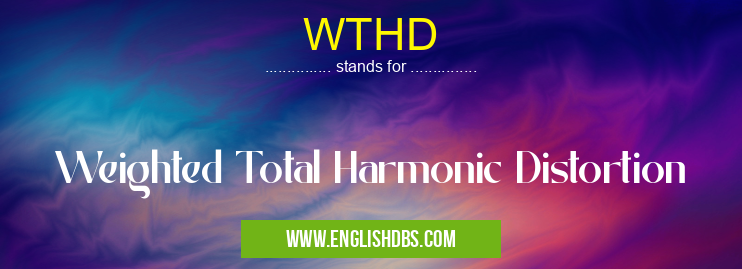What does WTHD mean in ELECTRONICS
Weighted Total Harmonic Distortion (WTHD) is a measure of the quality of audio generated by an electronic system. It is used to monitor distortion in audio systems and evaluate their performance. It is a metric used to measure both harmonic distortion and noise present in the signal and is usually determined using a complex mathematical calculation based on different frequency components of the signal. WTHD has become increasingly important for assessing audio performance, providing an indication of sound clarity and noise levels that affect speech intelligibility.

WTHD meaning in Electronics in Academic & Science
WTHD mostly used in an acronym Electronics in Category Academic & Science that means Weighted Total Harmonic Distortion
Shorthand: WTHD,
Full Form: Weighted Total Harmonic Distortion
For more information of "Weighted Total Harmonic Distortion", see the section below.
Essential Questions and Answers on Weighted Total Harmonic Distortion in "SCIENCE»ELECTRONICS"
What is Weighted Total Harmonic Distortion (WTHD)?
Weighted Total Harmonic Distortion (WTHD) is a metric that measures the distortion of amplified audio signals. WTHD measures the total amount of harmonic distortion produced by an audio system. WTHD combines the contributions from various harmonics, giving higher weight to more audible components such as higher order harmonics, and lower weight to less audible components such as lower order harmonics.
How is WTHD calculated?
WTHD is calculated by dividing the weighted sum of harmonic distortions by the fundamental frequency, then multiplying it by 100%. The weighted sum of harmonic distortion includes the contribution from each harmonic multiplied by its corresponding weight factor. The weight factors take into account how audible each harmonic would be to a listener.
How does WTHD differ from THD?
While both metrics measure harmonic distortion in audio systems, THD only measures the sum of all harmonic ratios up to a certain limit without taking into account how audible they may be to listeners. On the other hand, WTHD gives higher weight to more audible components such as higher order harmonics, and lower weight to less audible components such as lower order harmonics in order to give an accurate measurement of total harmonic distortion produced by an audio system.
What is considered a good value for WTHD?
Generally speaking, anything below 1% WTHD is considered acceptable for most applications and anything below 0.1% WTHD should produce no noticeable distortion when listening. However, it should be noted that this can vary depending on application requirements and individual listening preferences.
Why is measuring WTHD important?
Measuring Total Harmonic Distortion (WTHD) allows engineers and designers to quickly assess the accuracy and fidelity of their amplifying or recording systems before they are released for sale or public use. High values of THD are usually indicative of high levels of distortion which would affect sound quality adversely and thus should be avoided at all costs.
Who uses THD measurements?
Audio engineers use THD measurements in order to test and optimize audio equipment performance before release for sale or public use. Companies manufacturing audio equipment also utilize these measurements in order to ensure their products have minimum levels of distortion that meet industry standards before releasing them onto the market.
Are there any industry standards related with WTDH?
With regards to industry standards, AES17-2015 specifies requirements for measuring Total Harmonic Distortion plus noise (“HD+N”) for loudspeakers which incorporates principles similar those used in calculating Weighted Total Harmonic Distortion (WTDH). This standard stipulates that any HD+N ratio greater than 0.7 dB will result in degraded sound quality and therefore should not exceed this level if possible.
Final Words:
WTHD provides an accurate way to assess audio performance and quantify unwanted distortions that could affect overall sound quality or speech intelligibility when playing music, streaming podcasts or talking on a phone call through an audio system or device. By using this metric as part of regular maintenance checks on equipment, greater awareness can be gained about potential defects before hearing them yourself, allowing for any necessary repairs or updates that could prevent unnecessary repair costs down the line.
